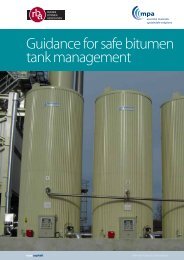GUIDE TO SAFE DELIVERY OF - Refined Bitumen Association
GUIDE TO SAFE DELIVERY OF - Refined Bitumen Association
GUIDE TO SAFE DELIVERY OF - Refined Bitumen Association
Create successful ePaper yourself
Turn your PDF publications into a flip-book with our unique Google optimized e-Paper software.
16 Guide to Safe delivery of <strong>Bitumen</strong> uK edition<br />
4<br />
Operation &<br />
maintenance<br />
of storage<br />
tanks and<br />
pipework<br />
4.2.3 Serviceability of content gauges must be regularly checked and maintained,<br />
with documentation recorded.<br />
4.2.4 Wherever possible a duplicate gauging system should be provided in the plant<br />
control room.<br />
4.3 Tank alarms<br />
Legislation/source documentation<br />
References 2, 13, 17<br />
Guidance<br />
4.3.1 A high level alarm (HLA) and an independent high high level alarm (HHLA) must<br />
be installed on each storage tank.<br />
4.3.2 The activation of the HHLA must be independent of the tank contents gauging<br />
system and set to trigger at the available capacity of the tank less 71 /2%.<br />
4.3.3 To avoid product spillage whilst the delivery hose/line is being cleared, the<br />
HLA should be set to trigger at the available capacity of the tank less 10%<br />
(see Appendix 3).<br />
4.3.4 Alarms must clearly identify which tank they refer to, when activated.<br />
4.3.5 Alarms must be audible and visible to all those responsible, including the<br />
delivery driver, for the safe delivery of product.<br />
4.3.6 In the event of an alarm being triggered ground based pumps should<br />
automatically switch off and must not re-start until the cause of the alarm has<br />
been investigated and resolved (see 5.2.9).<br />
4.3.7 Serviceability of alarms must be regularly checked and maintained, with<br />
documentation recorded.<br />
4.3.8 At high temperature the headspace of storage tanks can contain hydrogen<br />
sulphide, which may reach dangerous concentrations. Appropriate control<br />
measures should be applied which may include delineation of zones,<br />
information panels, detectors set to signal if concentrations approach the<br />
Occupational Exposure Limit (OEL), use of adequate local ventilation.<br />
4.4 Tank openings<br />
Legislation/source documentation<br />
References 2, 14



